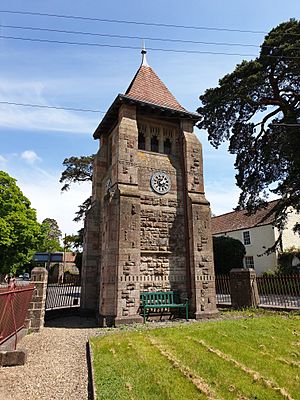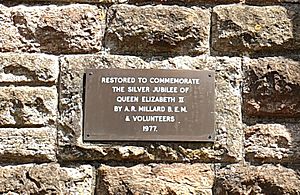Jubilee Clock Tower, Churchill facts for kids
Quick facts for kids Jubilee Clock Tower |
|
|---|---|

Jubilee Clock Tower
|
|
| Type | Clock tower |
| Location | Churchill, North Somerset, England |
| Height | 12 metres (40 feet) |
| Founded | 1897 |
| Founder | Sidney Hill |
| Built | 1898 |
| Built for | Queen Victoria's Diamond Jubilee |
| Restored | 1976–1977 |
| Architect | Joseph Foster Wood FRIBA of Foster & Wood, Bristol |
| Architectural style(s) | Perpendicular Gothic style |
| Governing body | Churchill Parish Council |
|
Listed Building – Grade II
|
|
| Official name: Jubilee Clock Tower and attached walls and railings | |
| Designated | 19 January 1987 |
| Reference no. | 1129198 |
| Lua error in Module:Location_map at line 420: attempt to index field 'wikibase' (a nil value). | |
The Jubilee Clock Tower is a special building in the village of Churchill, North Somerset, England. It's a Grade II listed building, which means it's important and protected. The tower has a clock that chimes and even a drinking fountain.
It was built to celebrate Queen Victoria's Diamond Jubilee in 1897. This was a huge celebration for her 60 years as queen! The tower stands proudly between two roads, Dinghurst Road and Front Street, making it a well-known landmark.
The tower was designed by Joseph Foster Wood from Bristol. It's made of local stone and looks like an old Gothic-style building, with tall, pointed features. Inside, it has a special clock mechanism that still works today.
The clock has four faces, one on each side, and they all run from the same inner workings. A company called J. B. Joyce & Co installed the clock in 1898. Volunteers still wind the clock every three days to keep it ticking!
The tower, along with its walls and railings, became a Grade II listed building on January 19, 1987. This happened almost 90 years after it was first built.
Contents
History of the Clock Tower
Why the Tower Was Built
In 1897, a kind local businessman named Sidney Hill bought some old, run-down land in Churchill. He wanted to make the area look nicer. His plan was to clear away the old buildings and plant pretty shrubs.
He also decided to build a clock tower on one of these spots. This tower would be a special way to remember Queen Victoria's Diamond Jubilee in 1897.
Designing the Tower
Sidney Hill hired Joseph Foster Wood, a famous architect from Bristol, to design the clock tower. This architect's firm, Foster & Wood, had designed many important buildings in Bristol, like schools and other public places.
Building the Tower
The tower was finished by the end of 1897. The bell and clock parts were put in the next year by J. B. Joyce & Co. On July 31, 1901, Sidney Hill gave the clock tower to a local trust that looked after the church and school.
An architect who used to work with Joseph Foster Wood later said that the Churchill tower was a "charming memorial" and showed off Wood's original ideas.
Taking Care of the Tower
By 1974, the tower's walls were starting to crumble, and the stonework needed repairs. The clock's winding system was also in bad shape. The trust that owned the tower didn't have enough money to fix everything.
It became clear that the tower needed more help. People thought it should either become a protected historic monument or the local council should take over its care. In 1976, the trust asked the council to take responsibility.
In 1977, for Queen Elizabeth II's Silver Jubilee, the tower was cleaned by a local volunteer, Arthur Raymond Millard, and his team. A plaque was later put on the tower in 1979 to thank them for their hard work.
Today, the Churchill Parish Council is in charge of keeping the clock tower in good condition. They even treated the tower with a special chemical in 1980 to stop pigeons from making a mess on the stonework!
What Makes the Tower Special?
The Jubilee Clock Tower has a cast iron clock face on each of its four sides. These faces have Roman numerals to show the hours. The tower itself is square and has strong supports called buttresses on its lower part.
All four clock faces are powered by one single mechanism inside the tower. The second floor is where you'll find the clock's inner workings and the bell.
On the east side of the tower, there's a special nook with a drinking fountain. It has a cast iron tap and water pump parts. This fountain was meant to provide water for both people and animals.
There's also a bench nearby and a new path that makes it easier for everyone to visit the tower.
Below the bell floor, there's an inscription carved into the stone. It tells us why the tower was built:
- West side: "JUNE 20 1897 THIS TOWER"
- South side: "& CLOCK WAS ERECTED BY SIDNEY HILL JP OF LANGFORD HOUSE IN"
- East side: "THIS PARISH TO COMMEMORATE THE SIXTY YEARS OF THE BENEFICENT"
- North side: "REIGN OF HER MOST GRACIOUS MAJESTY QUEEN VICTORIA"
Images for kids






